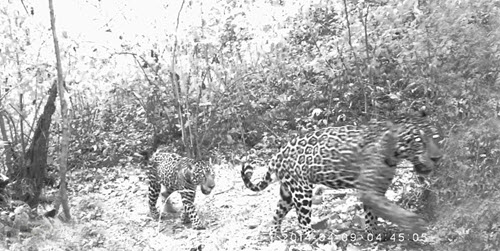VENTURA — Jaguars once roamed in the wild from South America into parts of the United States. Now, jaguar populations are dwindling, they have been almost completely eliminated from the US, and these majestic creatures are classified as “near threatened.”
Wildlife conservation organization Paso Pacifico has a program in place to monitor and protect jaguars in Nicaragua, but they know they can’t accomplish this mission alone. Luckily, they aren’t the only ones who believe in this cause.
The Los Angeles Zoo has joined forces with Paso Pacifico to support their jaguar conservation efforts and provide funding for 14 camera traps in the Paso del Istmo Biological Corridor on the western slope of Nicaragua. These motion-activated cameras were installed in strategic locations in the region, with the ultimate goal of documenting the presence of jaguars.
“Jaguars have historically been an important species at the Los Angeles Zoo,” said Beth Schaefer, general curator at the Los Angeles Zoo. “They are the flagship species in our Rainforest of the Americas exhibit and play an important role in connecting Angelenos with wildlife in the Americas. The Los Angeles Zoo is proud to be a long-time supporter of Paso Pacifico’s camera trap project, enabling them to gather critical data about this magnificent predator. It is conservation projects like this that gain the science needed to save wild animals and their habitats.”
***The Los Angeles Zoo is a member of the Association of Zoos and Aquariums, a nonprofit organization dedicated to the advancement of zoos and aquariums in the areas of conservation, animal welfare, education, science, and recreation.
Capturing footage of jaguars is the primary goal, but the camera traps often pick up activity from other animals that can provide clues about their existence in the area, as well as overall forest health.
Camera traps recently recorded peccaries (hoofed, pig-like mammals) in the Paso del Istmo Corridor. Jaguars prey on peccaries, so the presence of peccaries in the region could translate to a potential for additional jaguars nearby as well.
“Before jaguars were picked up on camera a few years ago, it was widely believed that they no longer existed in the Paso del Istmo Corridor in Nicaragua,” said Paso Pacifico Founder and Executive Director Dr. Sarah Otterstrom. “Now that there is clear, visual evidence that they still roam the local forests, we can work together to educate communities about the importance of protecting them.
“Our partnership with the Los Angeles Zoo is so important for the future of jaguars in Nicaragua. Not only do they generously provide the funding for our camera traps, but they educate Zoo visitors about the critical need to monitor and protect jaguars in Central America. Thank you to the team at the LA Zoo for your commitment to wildlife conservation.”
Once proof of their existence has been established, Paso Pacifico then works with local communities to spread the word about the importance of protecting these creatures.
Unfortunately for jaguars in Nicaragua, the biggest threat to their survival is tied to activity from human predators. Farmers and ranchers in Nicaragua typically shoot jaguars on sight, as deaths of cattle and horses have often been attributed to jaguars. To combat this issue, Paso Pacifico has implemented a compensation program, offering to pay farmers in the event of a verified jaguar attack on their livestock.
Another factor contributing to the decline of jaguars is major deforestation in the region that has damaged their natural habitat. Paso Pacifico has a history of successful reforestation campaigns, including a 2008 project called “Return to Forest” that planted 750,000 trees in Nicaragua. This project was the first in Latin America to receive the “Gold” rating of the Climate, Community & Biodiversity (CCB) Standards. They recently launched another significant reforestation fundraising campaign called “Million Trees by 2020” to fight the effects of climate change, help restore and connect wildlife corridors in the region, and provide food for local families. As the name indicates, Paso Pacifico has set out to plant one million native trees in Central America by the end of 2020, with a fundraising goal of $10 million to plant, monitor, and care for the trees.
About Paso Pacifico: The mission of Paso Pacifico is to restore and protect the Pacific Slope ecosystems of Mesoamerica. These habitats include the endangered dry tropical forest, mangrove wetlands, and eastern Pacific coral reefs. By working with local communities, landowners, and partner organizations, Paso Pacifico restores and protects the habitats that form building blocks for wildlife corridors. Paso Pacifico also lends its expertise to help migratory wildlife on the Central Coast of California, including threatened migratory birds and whales that overwinter in Mesoamerica. Through its high-impact programs, Paso Pacifico has established itself as one of the world’s leading biodiversity conservation organizations. To learn more about Paso Pacifico and all of their wildlife conservation projects, visit pasopacifico.org
About the Los Angeles Zoo: Accredited by the Association of Zoos and Aquariums (AZA), the landmark Los Angeles Zoo and Botanical Gardens, drawing nearly 1.8 million visitors each year, is home to a diverse collection of 1,400 animals representing 270 different species, 58 of which are endangered. Its lush grounds on 113 acres feature a botanical collection comprising over 800 different plant species with approximately 7,000 individual plants. The Zoo is located in Griffith Park at the junction of the Ventura (134) and Golden State (5) freeways. Admission is $21 for adults and $16 for children ages 2 to 12. The Zoo is open from 10 a.m. to 5 p.m. daily. For information, call (323) 644-4200 or visit the L.A. Zoo Web site at www.lazoo.org

